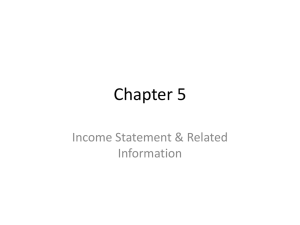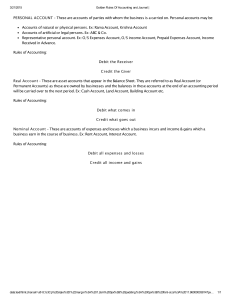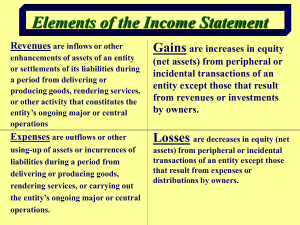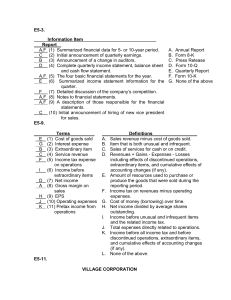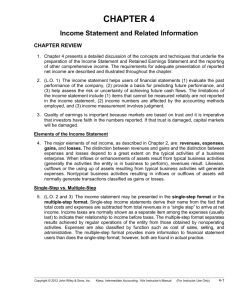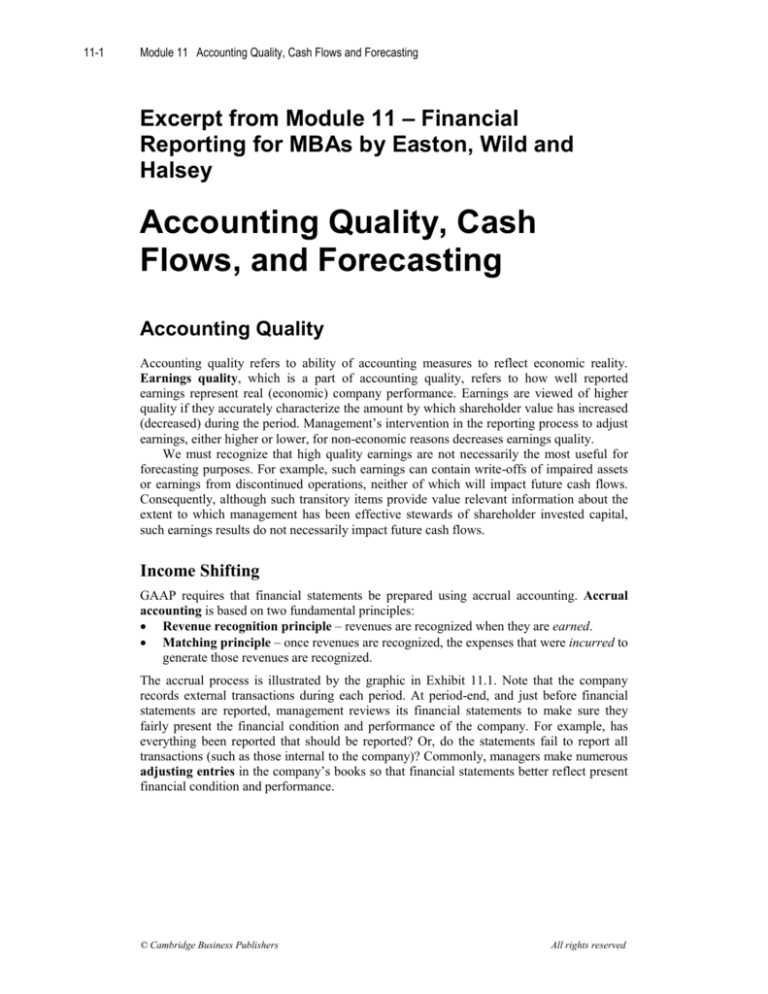
11-1
Module 11 Accounting Quality, Cash Flows and Forecasting
Excerpt from Module 11 – Financial
Reporting for MBAs by Easton, Wild and
Halsey
Accounting Quality, Cash
Flows, and Forecasting
Accounting Quality
Accounting quality refers to ability of accounting measures to reflect economic reality.
Earnings quality, which is a part of accounting quality, refers to how well reported
earnings represent real (economic) company performance. Earnings are viewed of higher
quality if they accurately characterize the amount by which shareholder value has increased
(decreased) during the period. Management’s intervention in the reporting process to adjust
earnings, either higher or lower, for non-economic reasons decreases earnings quality.
We must recognize that high quality earnings are not necessarily the most useful for
forecasting purposes. For example, such earnings can contain write-offs of impaired assets
or earnings from discontinued operations, neither of which will impact future cash flows.
Consequently, although such transitory items provide value relevant information about the
extent to which management has been effective stewards of shareholder invested capital,
such earnings results do not necessarily impact future cash flows.
Income Shifting
GAAP requires that financial statements be prepared using accrual accounting. Accrual
accounting is based on two fundamental principles:
Revenue recognition principle – revenues are recognized when they are earned.
Matching principle – once revenues are recognized, the expenses that were incurred to
generate those revenues are recognized.
The accrual process is illustrated by the graphic in Exhibit 11.1. Note that the company
records external transactions during each period. At period-end, and just before financial
statements are reported, management reviews its financial statements to make sure they
fairly present the financial condition and performance of the company. For example, has
everything been reported that should be reported? Or, do the statements fail to report all
transactions (such as those internal to the company)? Commonly, managers make numerous
adjusting entries in the company’s books so that financial statements better reflect present
financial condition and performance.
© Cambridge Business Publishers
All rights reserved
Module 11 Accounting Quality, Cash Flows and Forecasting
Exhibit 11.1 Accrual Process Illustrated
Transactions recorded
Beginning
of period
Adjusting entries recorded
End of
period
Common examples and sources of adjusting entries follow:
Write-off of impaired assets such as inventories, plant assets, or goodwill.
Increases or decreases in the allowance for uncollectible accounts.
Accruals of incurred, but unpaid, liabilities such as the accrual for employee wages and
for contingent liabilities (product warranties, environmental clean-up, etc.).
Accruals of earned, but uncollected, receivables such as the accrual for interest earned
and for earnings on long-term contracts.
Accruals typically increase the quality of earnings—reflecting revenues when earned
and expenses when incurred. For example, assets are written off and the loss reported when
they become impaired, not when the assets are actually sold. This means the impairment
loss is reported on a timelier basis. Similarly, the expected loss on uncollectible accounts is
reported when estimated, rather than when accounts are actually written off. This provides
timely information about potential uncollectibles. Also, expected expenses for warranties
and wages earned by employees are recorded in the same period that the associated
revenues are reported. This provides a better representation of income earned for that
period. Each of these adjustments, and a myriad of others, yields higher quality earnings and
financial statements that are a fairer representation of the company’s financial condition and
performance.
We must also recognize that sometimes managers intervene in the reporting and
adjustment process in an attempt to bias the reports to achieve a particular objective.
Consider the following cases:
Case 1: A company is in a depressed market and will not achieve Wall Street’s earnings
expectations. Its stock price has fallen and is not likely to recover anytime soon.
Management initiates a restructuring plan to correct the company’s ills. Concurrent
with the recognition of costs relating to this plan, management decides to write off an
excessive amount of assets and accrues an excessive amount of liabilities (more than is
warranted). The effect of these accruals is to overly depress current income.1 This is
sometimes referred to as a big bath. In subsequent periods, income is higher than it
should be since some costs have been prematurely removed from the balance sheet and
expenses have been recognized in an earlier period than was warranted.
Case 2: A company expects to be short of its income target by a relatively small
amount. At period end it accrues an insufficient allowance for uncollectible accounts or
an insufficient liability for product warranties. The effect of such actions is to increase
current period income by the amount that accrued expenses are understated. Future
periods’ income will be lower, however, as these costs are eventually recognized.
Case 3: A company will fall short of income targets. To boost current period income it
(a) sells appreciated available-for-sale securities, thus recognizing a gain on the sale and
boosting income, or (b) reduces advertising, research and development, and
maintenance expenses and, thereby, increases current income.
1
The accounting mechanics involve recording an expense and either reducing the carrying value of
assets or increasing liabilities.
© Cambridge Business Publishers
All rights reserved
11-2
11-3
Module 11 Accounting Quality, Cash Flows and Forecasting
The first two cases are attempts to manage earnings via accruals. Management has used
accrual adjustments to reduced current period income, and has set the stage for increased
future profitability, thus shifting income to the future.2 Is this proper? No. Do some
managers do this? Yes.
Earnings management got so out of hand in the late 1990s that Arthur Levitt, former
chair of the SEC, chastised the financial community (financial statement preparers, auditors,
analysts, and security companies) for engaging in and condoning such behavior.3 His main
concern was that managers were using accruals to manage earnings to consistently reach
Wall Street earnings targets.
The third case presented above is an example of operational changes that companies
can make to influence income. The sale of securities is called gains trading; a practice of
selling over-appreciated or devalued securities to recognize previously unrecognized gains
or losses on available-for-sale securities.4 The reduction of advertising, R&D, and
maintenance directly increases current period income as each of these costs is immediately
expensed. Although current income is higher, long-term profitability will decrease. That is,
management has increased current income at the expense of future profitability, thus,
shifting income from the future to the present.
Business Insight
Old Dog, New Trick Cookie jar reserves are an old management trick. To illustrate, say
management announces a ‘restructuring’ plan for layoffs and plant closings. Next, it takes a big
charge to income – which it advises investors to ignore because it is a ‘special’ or ‘one-time’
charge – that covers costs of executing the plan and sets up liabilities on its balance sheet. Then,
lo and behold, restructuring costs turn out less than expected, allowing management to reach
into the corporate ‘cookie jar’ and reverse part of the reserves, yielding an income boost.
The FASB continues to try and stop this activity. As of 2003, when management plans to exit
from or dispose of a segment, it isn’t allowed to set up liabilities to reserve for future costs.
Instead, they must recognize such costs as they are incurred. Problem solved? Not quite.
The new FASB initiative did not address restructuring plans in connection with a merger or
acquisition. So, for the time being, companies still can set up reserves for acquisition-related
restructurings. However, even that option should have a limited life. Many expect new FASB
guidance that will force management to recognize acquisition-related restructuring costs as
incurred (Wall Street Journal 2003).
Another somewhat related activity is income smoothing, which is the management of
earnings in a desire to reduce income variability over time. This activity is often condoned
as providing outsiders with a better measure of the company’s core earnings. As we know,
core earnings are the most value-relevant since they best reflect future performance.
However, smoothed income is not necessarily the highest quality measure of core earnings.
We must recognize that management is attempting to sway our analysis process.
Management should stick to providing financial statements that fairly present the financial
condition and performance of the company.
By removing costs from the balance sheet in the case of the write-off, the company’s future
profitability is higher since these costs will no longer be recognized as expenses in future periods.
Also, by overestimating the allowance for uncollectible accounts or product warranty liability, the
company can later reverse these entries (or avoid the need for future increases), thus increasing future
period income. This means the company has shifted income from the present to the future.
3
See “The numbers game," remarks by chair Arthur Levitt of the Securities and Exchange
Commission, NYU Center for Law and Business, New York, N.Y., September 28, 1998.
4
Why would a company sell devalued securities? It may feel that the long-term prospects for the
securities’ recovery are unfavorable. Also, if its income is above Wall Street expectations, it can now
absorb the loss and still meet those targets (and purge unwanted securities from its portfolio).
2
© Cambridge Business Publishers
All rights reserved
Module 11 Accounting Quality, Cash Flows and Forecasting
Organic versus Acquired Income
Analysts often distinguish between organic income and acquired income. Specifically, it
is useful know what portion of a company’s sales and profitability are from operations in
effect at the start of the year (organic) versus those that are acquired or constructed during
the year. To illustrate, Target makes the following disclosure in its 2003 annual report:
Target reports a 9.7% growth in total revenue for 2003. However, its ‘comparable-store’
growth is but 2.9%, where comparable-store refers to operations in effect at the beginning
of 2003. Only 2.9% of the revenue growth is “organic” growth (e.g., growth form existing
stores), while 6.8% of the 9.7% is acquired growth.
Such disclosures are important because acquired growth is often expensive. If its core
operations are not strong, management can find itself having to invest large sums of money
in new store locations and interior improvements to maintain its growth. The result is
deterioration in free cash flows (net cash flow from operations less capital expenditures).
Target also discloses the following information related to store expansion for the year:
Further, Target discloses the following information on its capital expenditures program:
© Cambridge Business Publishers
All rights reserved
11-4
11-5
Module 11 Accounting Quality, Cash Flows and Forecasting
Notice that its capital expenditures relating to new stores were $2,223 million (3,004 million
x 74%) in 2003, or approximately $22 million ($2,223 million/ 101 new stores) per new
store. Projections of continued sales growth at the 2003 level will, therefore, entail similar
expenditures unless we expect retail markets to improve.
Company growth through acquisitions usually requires considerable costs, although this
can be in the form of additional common shares outstanding (dilution) instead of cash
outflows. For example, in 2002, Hewlett-Packard (HP) acquired all of the outstanding
stock of Compaq for a total purchase price of $24.2 billion, paid via the issuance of
approximately 1.1 billion shares of HP common stock and increasing HP’s outstanding
shares by over 50%.
Acquired growth also has reporting implications. That is, only the income of the
acquired company subsequent to the acquisition date is included in the income of the
consolidated group (see Module 7 for a discussion of consolidations). Similarly, sales and
expenses for the consolidated group are increased by the sales and expenses of the acquired
company post-acquisition.5
Many companies achieve their growth through acquisitions. Tyco International, Ltd.,
is a noteworthy example—see the following box on acquired versus organic growth. Our
analysis must be aware of the costs of acquired growth, as it is generally more expensive
than organic growth, and the implications for future performance.
Business Insight
Pitfalls of Acquired Growth
It may be the greatest destruction of shareholder value in
history, and it happened in the boom between 1995 and 2001. During the wave of mergers and
acquisitions in that bull market, many shareholders suffered for investing in companies that had
merger fever. The winners were shareholders of target companies who sold their stock within
the first week of the takeover. The subsequent year’s returns of most shareholders of purchasing
companies fell below those of their industry peers.
What went wrong with mergers? The short answer is that companies overpaid as a result of
5
The SEC allows an alternate accounting procedure under which sales and expenses for the entire
year are included in the consolidated totals, and income up to the acquisition date are backed out as an
expense, thus reducing reported net income to that which has been earned subsequent to the
acquisition. Although net income is the same under either approach, sales totals can appear higher
under this method of accounting.
© Cambridge Business Publishers
All rights reserved
Module 11 Accounting Quality, Cash Flows and Forecasting
overestimating the gains of the cost-cutting and synergies such mergers would bring. Then, they
failed to quickly integrate operations and systems. The results? Fully 61% of corporate buyers
reduced their own shareholders’ wealth. Companies that paid for mergers solely in stock had
poorer results than those using cash. The most disappointing deals were in technology (see
Business Week 2002).
Baited by investment bankers looking for fat fees, companies with high price-earnings (PE)
ratios sought to buy companies with lower PE's to juice up their performance and income. Serial
acquirers bought hundreds of companies to keep the momentum going and to please the Street.
Tyco International Ltd. bought more than 700. A merger seemed easier than organic growth,
but time proved it was not.
Pensions Effects on Income
Pension expense reported in the income statement is computed as follows (see Module 10):
+
–
±
=
Service cost
Interest cost
Expected return on pension plan investments
Amortization of deferred losses (gains)
Pension expense
In our analysis of income, we must be mindful of the magnitude and classification of
pension expense. Most analysts consider the service cost component an operating expense,
since it reflects the cost of employees working another year. The interest cost component is
generally viewed as a financing cost, and the expected return on plan assets is likewise
viewed as non-operating component. Consequently, any analysis and adjustment entails the
parsing of pension expense into operating and non-operating components.
To illustrate, Target provides the following pension-related disclosure in its 2003
annual report:
In 2003, Target recognized net pension expense in the amount of $46 million. This amount
included $114 million in expected return on pension assets, which nearly offset its pension
costs arising from service and interest (Target’s actual return on pension investments in
2003 was a gain of $203 million). Our analysis might recast these income effects to exclude
interest costs and the expected return from plan assets from Target’s operating income.6
6
Target also reports $18 million relating to the amortization of recognized losses and $7 million
of recognized prior service cost. There relate to the amortization of deferred gains and losses
which we discuss in Appendix 10B. The amortization of deferred investment-related gains and
losses should properly be treated as non-operating, while the amortization of deferred gains and
© Cambridge Business Publishers
All rights reserved
11-6
11-7
Module 11 Accounting Quality, Cash Flows and Forecasting
Business Insight
How Pensions Confound Income Analysis Overfunded pension plans and boom markets
can yield huge additions to income. As recently as 2000, when the markets continued to rise,
pension investments realized large gains that flowed directly into income. Remember that even
though pension assets do not belong to shareholders (they are the legal entitlement of current and
future retirees), accounting rules require companies to report the gains and losses from those
assets in income. Until recently, not many companies complained. For example, Fortune (2002)
reports that in 2000, pension gains were $1.74 billion, or 9%, of GE's pretax income, and IBM's
pension plan contributed $1.2 billion—more than 10% of its income. When markets reverse,
however, such gains can evaporate and ultimately leave the company with insufficient resources
to pay retiree claims. Our question from an analysis viewpoint is whether investment returns and
interest on the pension obligation are operating activities.
Debt Retirement Effects on Income
Bond and note liabilities are carried on the balance sheet at historical cost (original issue
price plus or minus any unamortized premium or discount). The market values of these
securities vary inversely with fluctuations in interest rates. When such debt is repurchased
in the open market or acquired via a call provision, the difference between the purchase
price and the book value of the debt is recorded as a gain or loss in the income statement.7
Although such gains and losses on debt repurchases are reported in income, no gain or
loss occurs in an economic sense. Thus, such gains and losses are irrelevant for income
analysis. They are also irrelevant for cash flow analysis (see Appendix 8B). As a result, we
must adjust income to eliminate the effect of these gains and losses as part of our
prospective analysis.
Cash Flow Analysis
Given the importance of cash flows in analysis and planning, it is natural to ask, ‘Can the
statement of cash flows be managed?’ The short answer is yes. To start, there are sufficient
incentives as managers are aware of the importance placed on net cash flows from
operations and most seek to maximize this reported figure. Some managers use operational
means to increase reported operating cash flows. Some managers use financial techniques.
And some managers, if desperate, resort to means outside of GAAP to achieve their
reported cash flow target.
Recall that, in its simplest form for sake of discussion, net cash flow from operations is
computed as follows:
Net income
+
Depreciation and amortization expenses
+(-) Decrease (increase) in noncash current assets
+(-) Increase (decrease) in current liabilities
+
Accrued expenses
Accrued revenues
=
Net cash flows from operations
losses relating to plan amendments, such as the amortization of prior service cost, should be
treated as operating.
7
Classification of these gains and losses as ordinary or extraordinary items depends on whether they
meet the test for extraordinary items of being unusual and infrequent.
© Cambridge Business Publishers
All rights reserved
Module 11 Accounting Quality, Cash Flows and Forecasting
See that operating cash flows are increased by the increase in cash operating income, by a
decrease in current assets (receivables and inventories), by an increase in current liabilities
(payables), and by an increase in accrued expenses. Although an improvement in operating
cash flows is generally viewed favorably, it is necessary to understand the drivers of this
increase to discern the extent to which future cash flows are expected to exhibit similar
behavior.
Following are common issues that we must consider in our analysis and interpretation
of operating cash flows:
Operating cost reductions. Operating cash flows increase with increases in net
income. For the most part, income increases are a positive indicator. However, if the
income increase is from reductions of necessary operating costs, the benefits might be
short-lived. Examples are cutbacks in advertising, maintenance, and research and
development. Each of these is a necessary operating expense and is important for the
company to maintain its competitive position. Thus, short-term benefit for income and
operating cash flows might be at a longer-term cost.
Tax benefits from exercise of employee stock options. The IRS considers the cost of
employee stock options a tax-deductible expense, even if they are not recognized as an
expense in the income statement. As a result, taxable income and taxes payable are
reduced when options are exercised, thereby increasing operating cash flow. The
increase in operating cash flow from the reduction of taxes payable will not be
sustained, however, if the market price of the stock falls and the options are not
exercised. We should be skeptical of including this inflow in our projection of operating
cash flow.
Accounts receivable reductions. Reductions in accounts receivable increase net cash
flows from operations. A key analysis question is whether this source of operating cash
flows is sustainable. There are many instances where this is not the case. Consider the
following:
Restrictive credit policies. A company can achieved the collection of receivables by
implementing overly restrictive credit policies which might damage it relations with
customers and negatively impact future sales. The change in credit or collection
policies will, most likely, be revealed in a reduction of days' sales outstanding in
accounts receivable and a corresponding increase in the receivable turnover ratio.
Such a reduction can yield a short-term gain at a long-term cost.
Securitizations. Companies often sell accounts receivable to a financial institution or
a variable interest entity (VIE). If properly structured, the receivables are removed
from the balance sheet and a gain or loss is reported equal to the sales proceeds less
the net book value of the receivables transferred. This transaction is called
securitization (also called factoring). Operating cash flows will increase in the year of
sale. However, unless this process is continued in future years, operating cash flows
will decrease as receivables rise. Furthermore, many analysts consider this cash
inflow to be a financing activity (similar to borrowing against the receivables) and
not an operating activity.
Inventory reductions. Reductions in inventory increase operating cash flows.
Generally, companies wish to maintain an optimal level of inventory. Reductions in
excessive inventories are welcome. Examples are trimming work-in-process inventories
due to improved production techniques or elimination of slow-moving inventory from
finished goods. If inventories are reduced below what is necessary to conduct
operations, short-term gains in operating cash flows might come at long-term costs as
customers face stock-outs and the company’s image deteriorates. Many failing
companies reduce inventories to bolster cash flows—a short-term tactic that rarely leads
to survival.
Payable increases. Increases in accounts payable increase operating cash flow. This is
called leaning on the trade. Yet, after some point, the cash flow gains to be realized by
© Cambridge Business Publishers
All rights reserved
11-8
11-9
Module 11 Accounting Quality, Cash Flows and Forecasting
extending the payment of accounts payable come at the expense of supplier
relationships. Proper working capital management requires that accounts payable not be
paid before their due dates, but companies (and analysts) must not forget that suppliers
are their life-blood for continued, high quality materials and products.
Operating cash flows purchases. Companies can increase operating cash flows by
buying them. For example, subsequent to an acquisition, the purchased company’s
operating cash flows are added to those of the purchasing company. Cash acquisition
costs are reflected in investing activities, and noncash costs such as issuance of
common stock are not reflected in the statement of cash flows (they are recorded as a
noncash financing and investing activity). Tyco is a case example in the box below.
Business Insight
Tyco Purchases Operating Cash Flows
Management is aware of the market’s
fixation on operating cash flow, which are the main component of free cash flows and used for
stock valuation in the DCF model (see Module 3). In 2001, Tyco touted its free cash flows in a
press release: Free Cash Flow Reaches $1.7 Billion for The Fourth Quarter and $4.75 Billion for The
Fiscal Year. Said L. Dennis Kozlowski, Chairman and Chief Executive Officer of Tyco, "In this
tough environment, I am pleased to report that our mix of businesses continues to perform very well.
Additionally, strong cash flow generation throughout all of our businesses, funds further investment in
these businesses and provides the means to opportunistically expand them as circumstances allow.”
Later, Tyco admitted to spending $830 million in 2001 to purchase roughly 800,000 individual
customer contracts for its security-alarm business (ADT) from a network of independent dealers.
Cash outflows relating to this purchase were reported in the investing section of the statement of
cash flows. However, fees paid by these new customers were reported in net income and
immediately added its operating cash flows. The Wall Street Journal (March 2002) declared that
Tyco "is effectively buying earnings and operating cash flow" with its contract purchases.
We must scrutinize the statements of cash flows to examine whether or not reported
cash flows are impacted by any of the factors described above. If the cash flows are
impacted, they should be adjusted and recast to abstract from those effects. The adjusted
cash flows will then provide a better indication of the core cash flow generating ability of
the company—that is, cash flows that are more likely to persist into the future.
Recasting Financial Statements
Recasting is the process of adjusting financial statements based on results of our analyses.
This process is completed prior to projecting financial results. Recall that financial
statements are prepared in conformity with GAAP, a process that often yields conservative
numbers and relies on key assumptions and estimates. GAAP is also the result of a political
process, yielding many standards that reflect a compromise between various interest groups
vis-à-vis standards demanding the most informative numbers.8
Consequently, reported financial statements, although in conformity with GAAP, may
not agree with how you perceive the company should be accounted for from an economic
perspective. This often results in people adjusting the reported financial statements to more
8
Examples include the smoothing of pension expense and the partial capitalization of pension assets
and liabilities, footnoting of stock option expense rather than reflection of ESO costs in the body of
the income statement, operating lease treatment, and failure to consolidate variable interest entities
(VIEs).
© Cambridge Business Publishers
All rights reserved
Module 11 Accounting Quality, Cash Flows and Forecasting
‘accurately’ present the financial condition and performance of the company, and to better
identify core operations and results.
Following are examples of the types of adjustments that many people consider.
Income Statement Adjustments
1. Removing transitory items such as:
a. Gains and losses on sales of assets (long-term and investments)
b. Transitory items below income from continued operations (discontinued
operations, extraordinary items, and changes in accounting principles)
c. Restructuring expenses
d. Gains on stock issuances by subsidiaries
e. Losses on write-downs of assets (long-term and inventories)
f. Merger costs
g. LIFO liquidation gains
h. Gains and losses on debt retirement
i. Liability accruals deemed excessive
j. Gains from reductions of deferred tax valuation allowance
2. Separating operating and non-operating items
a. Treating pension service cost as operating
b. Treating pension interest costs and expected returns as non-operating
c. Treating debt retirement gains and losses as non-operating
d. Treating short-term fluctuations in tax expense as non-operating
e. Treating income from equity method investments as non-operating
3. Adding expenses not reflected in income
a. Employee stock option expense
b. Inadequate reserves for bad debts
c. Reductions of R&D, advertising, etc., to achieve short-term income targets
Balance Sheet Adjustments
1. Capitalization of operating leases
2. Consolidation of equity method investments
3. Consolidation of variable interest entities (VIEs)
4. Elimination of discontinued segments
5. Write-down of impaired goodwill
Statement of Cash Flows Adjustments
1. Recast cash inflows from asset securitization, from operating cash flows to financing
2. Eliminate operating cash flows that relate to tax benefits from exercise of employee
stock options
3. Eliminate operating cash flow gains from excessive increases in accounts payable
4. Recast operating cash flows from discontinued operations to non-operating section
Each of these adjustments is made to recast the financial statements to better reflect your
understanding of the economic condition and performance of the company. Once
adjustments are made, the recast financial statements will aid in projecting future financial
performance and condition.
Business Insight
What is eBay’s Income and Operating Cash Flows?
How much income did eBay
make over the past 5 years? Albert Meyer, an accounting sleuth who runs 2nd Opinion
Research says, "For the life of me, I wouldn't be able to tell." The main culprit is its stock options.
eBay's reported income from 1999 through 2003 is $840 million. Under GAAP, this doesn't
include its stock option costs of $827 million. If we subtract that cost, eBay has earned just $13
million in the past 5 years. Even that calculation—done using one of several possible models—
© Cambridge Business Publishers
All rights reserved
11-10
11-11
Module 11 Accounting Quality, Cash Flows and Forecasting
purports to only measure the value of options when granted.
There's another way. Meyer estimates that eBay employees pocketed $1.6 billion in optionbased compensation over this 5-year period. So, did the options cost $827 million or $1.6
billion? Consider that $1.6 billion is the cumulative figure eBay claimed as an expense on its
tax return. At $1.6 billion, eBay has lost $760 million for this period.
Concerning eBay’s cash flow, Steve Milunovich of Merrill Lynch believes that operating
cash flows should exclude what companies spend to buy back stock to offset option-related
dilution. This gets tricky in eBay's case because it, unlike many others, hasn't bought back any
stock. This means that, even if you're a stockholder who never sold a share, you own less of
eBay now than you did in 1999. Meyer estimates that had eBay bought back shares to enable
stockholders to maintain their ownership stake rather than seeing it decline, the cash cost would
have been $1.2 billion—which is huge relative to Bay's cumulative operating cash flow of $1.8
billion. (Fortune 2004)
© Cambridge Business Publishers
All rights reserved


